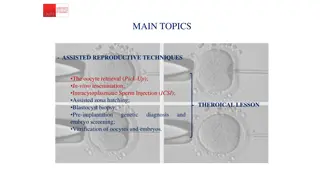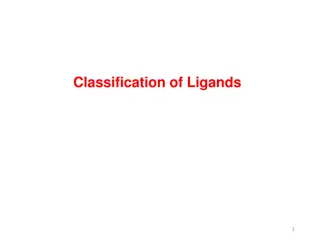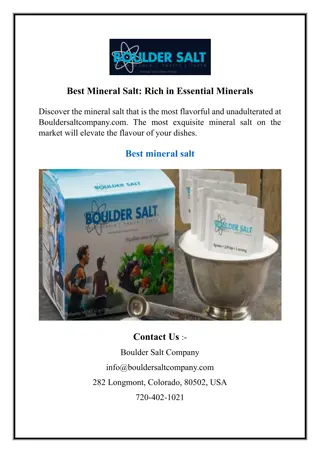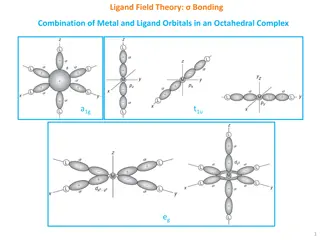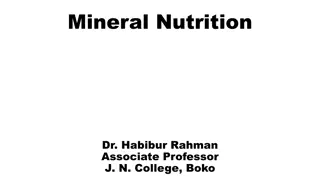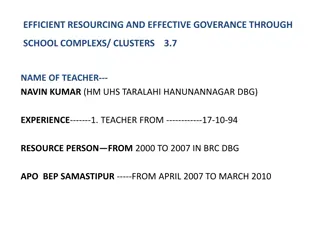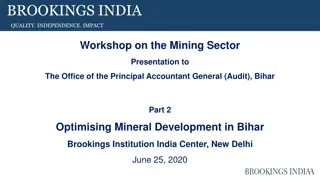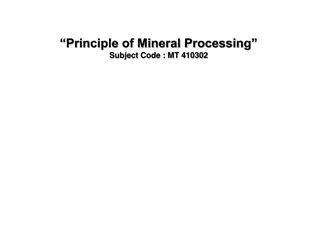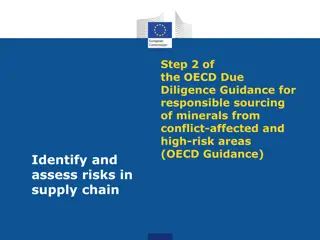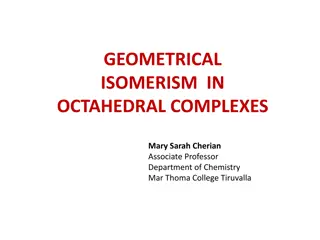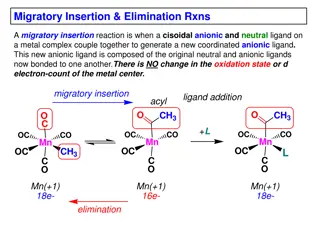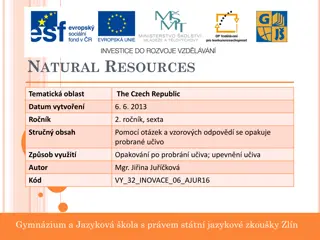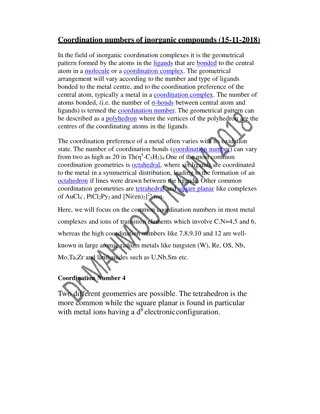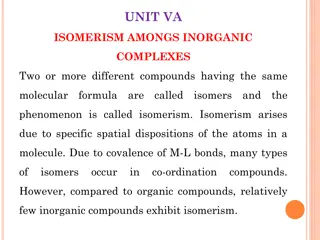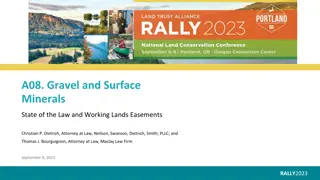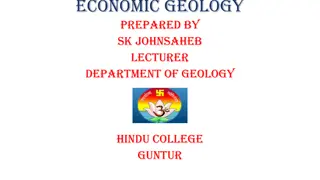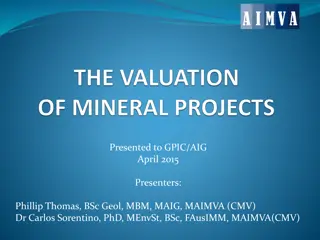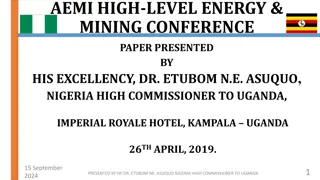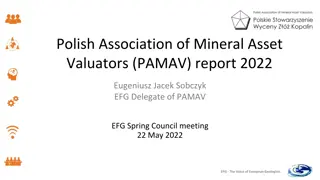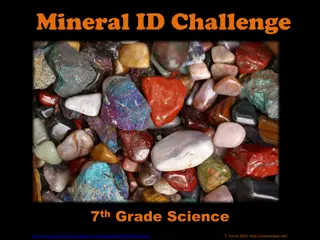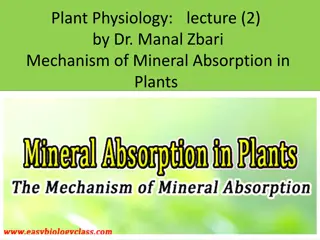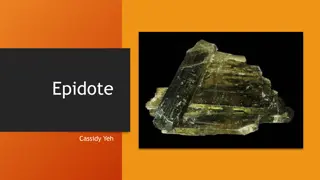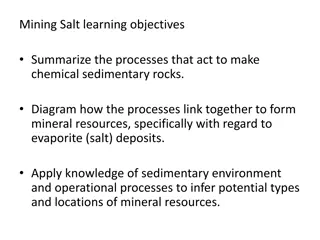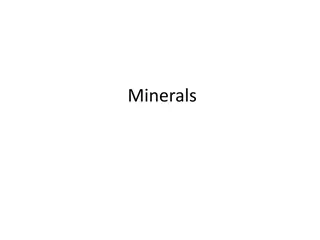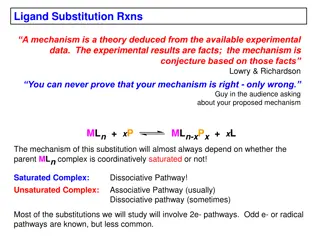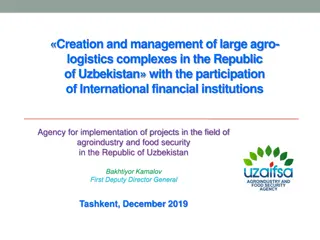Transition Metals Organometallic Compounds Overview
Transition metals bonded with organometallic compounds like metal alkyls, aryls, and hydrides are common in chemistry. Ligands are crucial for stabilizing these complexes, with carbon-based ligands exhibiting diverse binding modes based on the metal's hybridization state. Preparation methods for tra
1 views • 25 slides
Assisted Reproductive Techniques: Oocyte Retrieval Process
The process of oocyte retrieval in assisted reproductive techniques involves the careful retrieval of cumulus-oocyte complexes from follicular fluid under anesthesia and ultrasound guidance. These complexes are then sorted and stored before further procedures such as in-vitro insemination or intracy
1 views • 13 slides
Brain Mineral Deposition and Cognitive Decline Study
Investigating the progression pattern of brain mineral deposition as a differential indicator of cognitive decline in individuals with varying cognitive statuses from normal to Alzheimer's disease. The study aims to develop improved imaging techniques and specific cognitive-relevant atlases to under
4 views • 24 slides
Crystal Field Theory in Transition Metal Complexes
Crystal Field Theory (CFT) explains the colors and magnetic properties of transition metal complexes. It focuses on the energy changes in d-orbitals of metal ions caused by surrounding ligands. This theory, developed in 1929, provides insights into the bonding interactions in complex compounds. The
10 views • 44 slides
Ligands and Metal Carbonyl Complexes: A Comprehensive Overview
Explore the classification of ligands in metal complexes, including alkyl, aryl, and carbonyl ligands. Learn about the unique properties of carbonyl ligands, their preparation methods, and the molecular orbital diagram illustrating CO-metal bonding interactions.
5 views • 35 slides
Organometallic Chemistry III: Transition Metal Complexes and Homogeneous Catalysis
Explore the reactivity of transition metal complexes, including bond metatheses and various reactions. Learn about orbital considerations, synthesis, and spectroscopic properties of organometallic complexes. The course covers basics from AC1, focusing on ligands, electron counting, and MO diagrams.
5 views • 8 slides
Best Mineral Salt Rich in Essential Minerals
Discover the mineral salt that is the most flavorful and unadulterated at Bouldersaltcompany.com. The most exquisite mineral salt on the market will elevate the flavour of your dishes.\n\n\/\/ \/what-is-the-healthiest-salt\/
5 views • 1 slides
Understanding Ligand Field Theory in Octahedral Complexes
Ligand Field Theory explains the bonding interactions between metal and ligand orbitals in octahedral complexes. This theory involves the combination of metal and ligand orbitals to form molecular orbitals, leading to specific electronic configurations. The overlap of metal and ligand group orbitals
1 views • 10 slides
Understanding Cultural Traits and Complexes in Society
Culture is a complex whole that encompasses various aspects such as knowledge, beliefs, arts, morals, laws, customs, and more. Cultural traits, at the simplest level, are individual tools, acts, objects, or beliefs related to specific situations or needs, while cultural complexes are groups of inter
0 views • 18 slides
Understanding Plant Mineral Nutrition: Importance and Study Methods
Plant nutrition involves the synthesis, breakdown, and utilization of food by plants for their growth and development. Mineral nutrition is a vital aspect, with plants obtaining essential nutrients from soil in the form of mineral elements. Methods like hydroponics have been used to study plant mine
0 views • 40 slides
Efficient Resourcing and Effective Governance in School Complexes
This initiative aims to enhance school governance and resource utilization through the establishment of school complexes/clusters. By pooling resources, sharing staff, and promoting collaboration among schools, the system seeks to improve educational outcomes, support children with disabilities, and
0 views • 18 slides
Understanding the Applications and Design of Analytical Ultracentrifugation
Analytical ultracentrifugation, a powerful technique in biochemistry, allows for precise measurement of sample properties and characterization of macromolecular complexes. The method is widely used for determining sample purity, equilibrium constants, and assembly mechanisms of biological complexes.
1 views • 17 slides
Mineral Potential and Opportunities in Bihar
Explore the rich mineral potential of Bihar, from the diverse geology to the various minerals present in the region. Discover the mineral inventory, coal resources, and mineral availability in India and Bihar. Uncover insights into optimizing mineral development for economic growth.
0 views • 26 slides
Role of Transition Metal Complexes in Cancer Treatment
Transition metal complexes, such as platinum (II) compounds like cisplatin and carboplatin, have shown significant efficacy in treating various types of cancers. These complexes offer a promising approach for combating cancer with reduced side effects. Additionally, new generation compounds like pic
0 views • 15 slides
Principles of Mineral Processing in Extractive Metallurgy
Introduction to the principles of mineral processing focusing on the scope, physical characteristics, and economics of ore processing. The syllabus covers terminology, mineral resources in India, and the processing of industrial minerals like Haematite, Galena, and Chalcopyrite. Learn about ore depo
3 views • 20 slides
Legal Framework for the Mining Sector in Tanzania
The legal framework governing the mining sector in Tanzania is based on the Mining Act, Cap. 123, which regulates various aspects such as prospecting, mining, mineral processing, environmental compliance, and more. It outlines key issues including state control over mineral rights, acquisition of mi
0 views • 19 slides
Responsible Sourcing in Conflict-Affected Areas: OECD Guidelines
The OECD Due Diligence Guidance outlines steps for companies to identify and assess risks in mineral supply chains from conflict-affected and high-risk areas. It explains Conflict-Affected and High-Risk Areas (CAHRAs) and the importance of due diligence in responsible mineral sourcing to avoid finan
4 views • 16 slides
Geometrical Isomerism in Octahedral Complexes: A Comprehensive Overview
Geometrical isomerism in octahedral complexes is a fascinating phenomenon arising from different geometric arrangements of ligands. This type of isomerism is prevalent in coordination numbers 4 and 6, leading to two main types of geometric isomers. Examples of cis-trans and mer-fac isomers in MA2B4
5 views • 10 slides
Insights into Migratory Insertion and Elimination Reactions in Metal Complexes
Migratory insertion in metal complexes involves the coupling of a cisoidal anionic and neutral ligand to form a new coordinated anionic ligand without changing the metal center's oxidation state or d-electron count. This process requires cisoidality between the reacting ligands and a vacant coordina
0 views • 19 slides
Mineral Potential Assessment Techniques and Methods Explained
Comprehensive overview of mineral potential assessment methods using a mineral systems approach. Explore qualitative and quantitative approaches, GIS methods, and the assessment of mineral likelihood and prospects. Understand the advantages, disadvantages, and applications of different techniques fo
1 views • 18 slides
Microbiological Inspection of Mineral Water by Redox Potential Measurement
MicroTester is a validated method for rapid microbiological testing of various types of water such as mineral water and carbonated water. Real-time monitoring of microbial properties in water production is crucial for ensuring safety and quality. The energy for microbial growth comes from biological
0 views • 27 slides
Natural Resources and Mineral Deposits in the Czech Republic
The Czech Republic's natural resources include renewable sources like sun energy and water, as well as non-renewable resources such as mineral deposits and fuels like black coal and oil. The country has rich non-metal deposits and varied metal deposits. Mineral deposits are abundant, with significan
0 views • 8 slides
Coordination Numbers in Inorganic Compounds: Geometries and Structures
In inorganic coordination complexes, the coordination number refers to the number of atoms bonded to the central atom. Common geometries include octahedral, tetrahedral, and square planar, depending on the type and number of ligands. Transition metal complexes exhibit different coordination numbers
2 views • 8 slides
Isomerism in Inorganic Complexes: A Comprehensive Overview
Isomerism in inorganic complexes is a fascinating phenomenon arising from the specific spatial arrangements of atoms within molecules. This article delves into the types of isomerism found in coordination compounds, such as structural isomerism and stereoisomerism. The importance of studying isomers
0 views • 67 slides
Understanding Mineral Rights and Conservation Easements in Working Lands
The presentation explores the complex laws governing mineral rights and conservation easements, focusing on tax deductibility, case law, and practical applications for allowing limited gravel extraction. It delves into the basics of mineral estates, the proverbial "bundle of sticks" concept, and how
0 views • 51 slides
Understanding Economic Geology: A Comprehensive Overview
Economic geology, as discussed in the provided content, delves into the commercial and industrial utilization of Earth's resources. Covering topics such as mineral deposits, ores, gangue minerals, common economic minerals, and classification of mineral deposits, this field plays a crucial role in id
0 views • 33 slides
Understanding Mineral Reactions in Metamorphism
Mineral reactions play a crucial role in our comprehension of metamorphism, helping to estimate the pressures and temperatures rocks undergo. These reactions can be categorized as continuous or discontinuous, leading to different mineral products. Discontinuous reactions, exemplified by the transfor
0 views • 6 slides
Understanding Mineral Project Valuation and Appraisal Methods
This presentation by the Australasian Institute of Minerals Valuers & Appraisers delves into the importance of mineral property valuations, the methods used for valuation, the roles of valuers and technical appraisers, and the overall process involved. It highlights the necessity of valuations in va
0 views • 37 slides
Insights into African Energy & Mining: A High-Level Conference Paper by His Excellency Dr. Etubom N.E. Asuquo
The African Energy & Minerals Management Initiative recently organized a high-level conference on the future of the energy and mining industry in Africa. His Excellency Dr. Etubom N.E. Asuquo, Nigeria's High Commissioner to Uganda, presented on key mineral resources, energy sources, and the challeng
0 views • 20 slides
Mineral Absorption in Plants: Mechanisms and Types
Plants absorb minerals from the soil as ions through the roots, with the process of mineral absorption being distinct from water absorption. Mineral absorption in plants can occur through passive or active methods, each involving different mechanisms and energy requirements. Passive absorption is a
0 views • 14 slides
PAMAV Report 2022: Advancing Mineral Asset Valuation in Europe
Polish Association of Mineral Asset Valuators (PAMAV) has been actively involved in the harmonization of Polish and international mineral resource reporting and valuation systems. The association's main activities in 2021/2022 include updating the POLVAL Mineral Resources Valuation Code, expanding t
0 views • 5 slides
Mineral Identification Challenge for 7th Grade Science Students
Engage in a Mineral Identification Challenge where 7th-grade students will explore various minerals using color, streak, luster, transparency, texture, composition, density, crystal shape, cleavage/fracture, hardness, and special properties. Students will rotate through different stations, perform t
0 views • 11 slides
Understanding Coordination Complexes and Transition Metals
Today's lecture covers transition elements, coordination complexes, ligand types, geometries, naming, isomers, and bonding in coordination complexes. Transition metals form coordination complexes with metal ions, ligands, and counter ions. The types of ligands include monodentate and bidentate ligan
0 views • 24 slides
All About Arfvedsonite: Rare Mineral Formation and Properties
Arfvedsonite is a rare mineral that is only formed in iron-rich igneous intrusions associated with nepheline syenites and pegmatites. Discovered in 1823 and named after Swedish chemist Johan Arfwedson, it has a distinctive chemical formula and structure as an amphibole mineral. Its physical properti
0 views • 9 slides
Mechanism of Mineral Absorption in Plants: Active vs Passive Methods
Plants absorb minerals from the soil in the form of inorganic ions through both passive and active methods. Active mineral absorption requires metabolic energy, whereas passive absorption occurs along the concentration gradient by simple diffusion. The roots play a vital role in mineral absorption d
0 views • 14 slides
All About Epidote: Physical, Chemical, and Optical Properties
Epidote, a silicate mineral, is a rock-forming mineral with a crystal structure consisting of isolated and paired silica tetrahedra. It is found in rocks like epidosite and unakite, displaying colors of yellowish-green, green, brownish-green, or black. This mineral has a vitreous luster, a hardness
0 views • 11 slides
Formation of Salt Deposits: Processes and Mineral Resources
Understanding the processes involved in the formation of chemical sedimentary rocks, particularly evaporite deposits like salt, is crucial for inferring potential mineral resources. This involves concepts such as evaporation, chemical weathering, crystallization, and lithification, which link togeth
0 views • 4 slides
Understanding Minerals: Properties and Identification
Minerals are naturally occurring solid inorganic substances with definite compositions and structures. They are classified based on physical and chemical properties. This content discusses the definition of minerals, the conditions that classify gold as a mineral, distinguishing mineral characterist
0 views • 29 slides
Understanding Ligand Substitution Reactions in Metal Complexes
Ligand substitution reactions in metal complexes involve the replacement of one ligand with another, impacting the coordination around the metal center. The mechanism of these reactions, associative or dissociative, is influenced by factors like coordination saturation and electron count. Experiment
0 views • 20 slides
Implementation of Large Agro-Logistics Complexes in Uzbekistan
The Republic of Uzbekistan is focusing on creating and managing large agro-logistics complexes to enhance food security and agribusiness development. Government programs and international financial institutions are instrumental in funding and implementing these projects, aiming to increase agricultu
0 views • 13 slides

